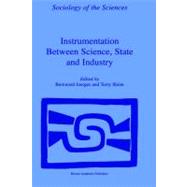
What is included with this book?
|
1 | (17) | |||
|
|||||
|
|||||
|
2 | (5) | |||
|
4 | (1) | |||
|
5 | (1) | |||
|
6 | (1) | |||
|
7 | (4) | |||
|
7 | (2) | |||
|
9 | (1) | |||
|
9 | (1) | |||
|
10 | (1) | |||
|
11 | (6) | |||
| PART I ORIGINS OF THE RESEARCH-TECHNOLOGY COMMUNITY | |||||
|
17 | (12) | |||
|
|||||
|
18 | (2) | |||
|
20 | (2) | |||
|
22 | (4) | |||
|
26 | (3) | |||
|
29 | (22) | |||
|
|||||
|
31 | (2) | |||
|
33 | (3) | |||
|
36 | (7) | |||
|
37 | (2) | |||
|
39 | (1) | |||
|
40 | (1) | |||
|
41 | (1) | |||
|
42 | (1) | |||
|
43 | (2) | |||
|
45 | (6) | |||
| PART II INTERSTITIAL WORLDS | |||||
|
51 | (18) | |||
|
|||||
|
52 | (3) | |||
|
55 | (3) | |||
|
58 | (2) | |||
|
60 | (3) | |||
|
63 | (6) | |||
|
69 | (28) | |||
|
|||||
|
71 | (3) | |||
|
72 | (2) | |||
|
74 | (5) | |||
|
75 | (2) | |||
|
77 | (2) | |||
|
79 | (5) | |||
|
79 | (1) | |||
|
80 | (2) | |||
|
82 | (2) | |||
|
84 | (2) | |||
|
86 | (7) | |||
|
87 | (4) | |||
|
91 | (2) | |||
|
93 | (4) | |||
|
97 | (24) | |||
|
|||||
|
|||||
|
|||||
|
|||||
|
98 | (2) | |||
|
100 | (1) | |||
|
101 | (2) | |||
|
103 | (8) | |||
|
103 | (2) | |||
|
105 | (4) | |||
|
109 | (2) | |||
|
111 | (4) | |||
|
111 | (1) | |||
|
112 | (3) | |||
|
115 | (6) | |||
| PART III PURVIEWS OF GENERIC INSTRUMENTS | |||||
|
121 | (22) | |||
|
|||||
|
122 | (5) | |||
|
127 | (1) | |||
|
128 | (1) | |||
|
129 | (1) | |||
|
130 | (8) | |||
|
138 | (1) | |||
|
139 | (4) | |||
|
143 | (32) | |||
|
|||||
|
145 | (2) | |||
|
147 | (2) | |||
|
149 | (3) | |||
|
152 | (6) | |||
|
158 | (6) | |||
|
164 | (2) | |||
|
166 | (4) | |||
|
170 | (5) | |||
|
175 | (24) | |||
|
|||||
|
176 | (4) | |||
|
177 | (1) | |||
|
178 | (2) | |||
|
180 | (3) | |||
|
183 | (9) | |||
|
184 | (2) | |||
|
186 | (3) | |||
|
189 | (3) | |||
|
192 | (7) | |||
| PART IV STANDARDIZED LANGUAGES | |||||
|
199 | (20) | |||
|
|||||
|
200 | (2) | |||
|
202 | (3) | |||
|
205 | (3) | |||
|
208 | (4) | |||
|
212 | (1) | |||
|
213 | (6) | |||
|
219 | (22) | |||
|
|||||
|
221 | (2) | |||
|
223 | (2) | |||
|
225 | (2) | |||
|
227 | (3) | |||
|
230 | (3) | |||
|
233 | (3) | |||
|
236 | (5) | |||
| IN CONCLUSION | |||||
|
241 | (8) | |||
|
|||||
|
|||||
|
241 | (4) | |||
|
242 | (1) | |||
|
243 | (1) | |||
|
244 | (1) | |||
|
245 | (1) | |||
|
246 | (3) | |||
| Bibliography of Selected References | 249 | (10) | |||
| List of Contributors | 259 | (2) | |||
| Bibliographical Notes on Contributors | 261 | (4) | |||
| Author Index | 265 |
The New copy of this book will include any supplemental materials advertised. Please check the title of the book to determine if it should include any access cards, study guides, lab manuals, CDs, etc.
The Used, Rental and eBook copies of this book are not guaranteed to include any supplemental materials. Typically, only the book itself is included. This is true even if the title states it includes any access cards, study guides, lab manuals, CDs, etc.